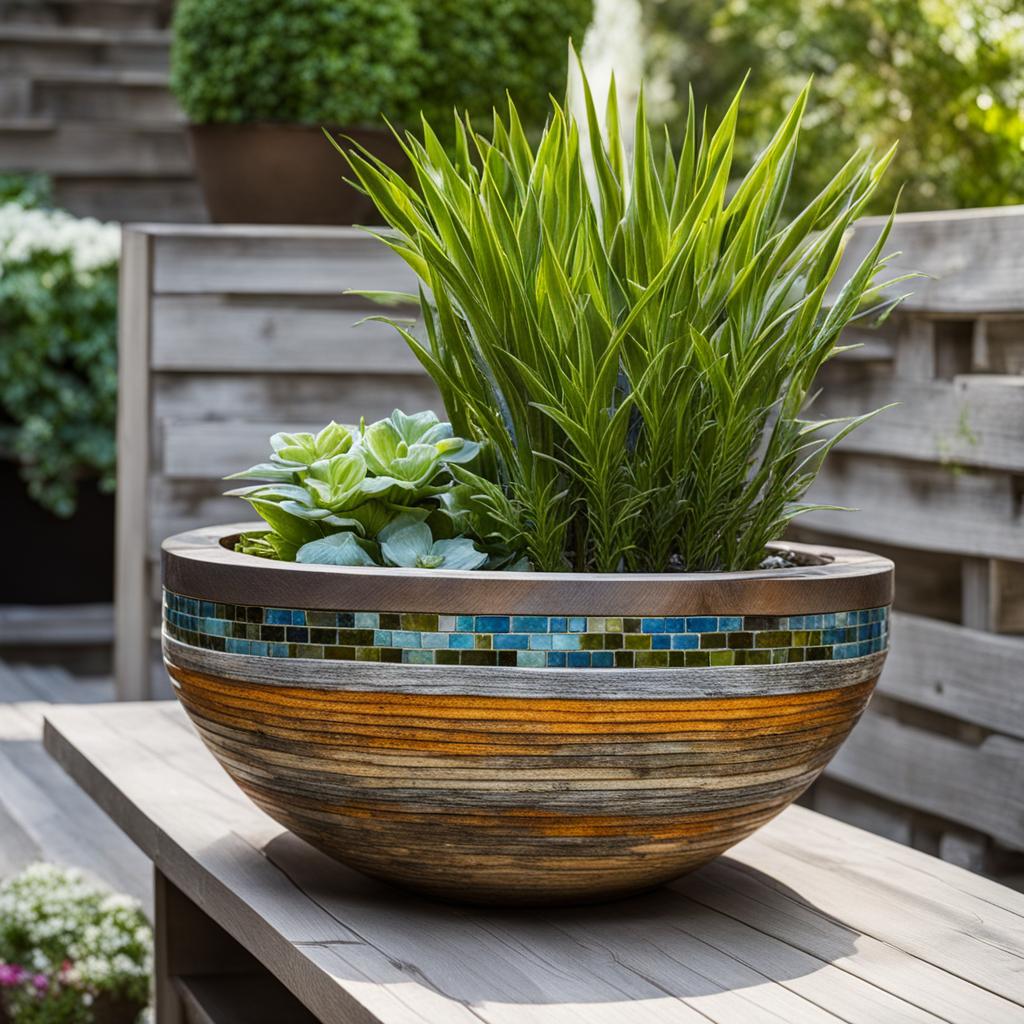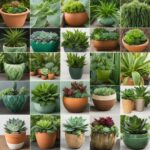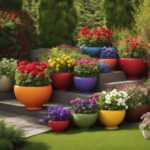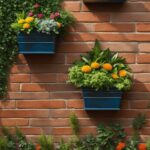Best Ideas For Planter: Inspiration for Growth (2024) Leave a comment
Looking to add a touch of creativity to your garden? In this article, I’ll share some of the best ideas for planters that will inspire growth and transform your outdoor space. Whether you’re a fan of vibrant and futuristic designs or prefer the eerie charm of gothic gardens, there’s something for everyone. Get ready to unleash your inner gardener and bring new life to your plants!
Key Takeaways:
- Discover the latest trends in planter design, including hortifuturism and gothic gardens.
- Learn how to create eye-catching displays with vibrant and futuristic planters.
- Find out how to attract essential pollinators like bees and butterflies to your garden.
- Maximize your vertical space with container gardening ideas.
- Embrace sustainability by incorporating native and carbon capturing plants.
Vibrant and Futuristic Planters: Embracing Hortifuturism
When it comes to embracing the hortifuturism trend, vibrant and futuristic planters are essential. These planters break away from traditional designs and instead showcase bold colors and sleek, modern materials that perfectly embody the vibrant and futuristic aesthetic.
To incorporate this trend into your garden, opt for planters in vibrant shades like neon green, electric blue, or hot pink. These eye-catching colors will instantly add a pop of excitement to your outdoor space. Look for unique planter designs that have a futuristic feel, such as geometric shapes or sleek, metallic finishes. These modern planters will create a visually engaging display that captures the essence of hortifuturism.
Once you have your vibrant and futuristic planters, it’s time to choose the perfect plants to complement them. Neon-colored plants with bright variegation are ideal for creating a stunning display. Think about incorporating plants with colorful foliage or vibrant flowers, such as neon Coleus, Caladium, or Begonia varieties. These plants will accentuate the vividness of your planters and bring the hortifuturistic theme to life.
In summary, embracing hortifuturism in your garden is all about vibrancy and modernity. By selecting vibrant and futuristic planters and pairing them with neon-colored plants, you can create a visually striking and on-trend outdoor space that is sure to make a statement.
Gothic Garden Ideas: Creating Dramatic Landscapes
Creating a gothic garden can add a touch of mystery and drama to your outdoor space. This trend, particularly popular among Gen Z gardeners, embraces dark and eerie elements that create a unique and captivating landscape. To bring the gothic theme to life, incorporate eerie plants with dark colors and textures. Black roses, dark purple lilies, and deep red tulips are excellent choices for adding a touch of drama to your garden.
When designing your gothic garden, consider using gothic-inspired pottery and statuary to enhance the haunting aesthetic. These elements can create a sense of antiquity and add a touch of elegance to your outdoor space. To enhance the atmosphere, focus on creating an evening experience by strategically uplighting trees and allowing plants to grow a bit untidy. Withered plants and faded blooms can also add to the gothic theme and create a sense of enchantment.
Additionally, consider reusing dying plants for merchandising instead of discarding them. By showcasing these plants in an artistic and intentional manner, you can embrace the beauty of imperfection and add an element of mystery to your gothic garden. Remember, the key to creating a gothic garden is to embrace the dark and eerie, allowing your creativity to flourish as you design a landscape that reflects your unique style and interests.
Table: Eerie Plants for a Gothic Garden
| Plant | Description |
|---|---|
| Black Roses | Deep, dark red or black velvety petals |
| Dark Purple Lilies | Large, trumpet-shaped blooms in rich shades of purple |
| Deep Red Tulips | Intense, blood-red petals that add a dramatic touch |
| Witch Hazel | Spidery, fragrant blooms with twisted branches |
| Black Mondo Grass | Dark, foliage that appears almost black |
| Bat Flowers | Unique black flowers resembling bats |
By incorporating these eerie plants and design elements into your garden, you can create a landscape that is both hauntingly beautiful and full of intrigue. A gothic garden allows you to express your individuality and creativity while embracing a style that stands out from the traditional. So, dare to be different and unlock the enchantment of a gothic garden in your own backyard.
Attracting Pollinators: Planting for Bees and Butterflies
Creating a pollinator-friendly garden is not only beneficial for the environment but also adds beauty and vibrancy to your outdoor space. By planting a variety of pollinator plants, you can attract bees and butterflies, which play a crucial role in pollination. These insects help plants reproduce, ensuring the growth of fruits, vegetables, and flowers.
To attract bees to your garden, consider planting bee-friendly plants such as bee balm, lavender, and sunflowers. These plants provide nectar and pollen, which are essential food sources for bees. You can also create a bee-friendly habitat by providing water sources, such as shallow dishes with pebbles for the bees to land on.
Butterflies are attracted to plants with bright colors and sweet, fragrant nectar. To attract butterflies to your garden, opt for butterfly-friendly plants like milkweed, butterfly bush, and zinnias. These plants provide food for both adult butterflies and their caterpillars. Additionally, consider including host plants specific to certain butterfly species, as they are essential for their life cycle.
Table: Pollinator Plants for Bees and Butterflies
| Plant | Attraction | Notes |
|---|---|---|
| Bee Balm | Bees | Also attracts hummingbirds |
| Lavender | Bees, Butterflies | Fragrant flowers |
| Sunflowers | Bees | Large, pollen-rich flowers |
| Milkweed | Butterflies | Host plant for monarch butterflies |
| Butterfly Bush | Butterflies | Fragrant flowers |
| Zinnias | Butterflies | Colorful flowers with nectar |
“Creating a pollinator-friendly garden is not only beneficial for the environment but also adds beauty and vibrancy to your outdoor space.”
Incorporating pollinator plants into your garden doesn’t just benefit the bees and butterflies; it also provides you with a delightful and colorful display of flowers. These plants attract an array of beneficial insects, adding life and movement to your garden. Additionally, by supporting pollinators, you are indirectly contributing to the overall health of ecosystems and the preservation of biodiversity.
Remember to provide a variety of flowering plants that bloom throughout the spring, summer, and fall seasons to ensure a continuous food source for the pollinators. Design your garden with a combination of annuals, perennials, and flowering shrubs to create a diverse and inviting environment for bees and butterflies.
By planting for bees and butterflies, you can transform your garden into a haven for these important pollinators. Embrace the natural beauty and benefits that come with creating a pollinator-friendly garden, and enjoy the sights and sounds of bees buzzing and butterflies fluttering in your own backyard.
Maximizing Vertical Space: Container Gardening Ideas
If you have limited gardening space, don’t fret! Container gardening is the perfect solution to maximize vertical space and still enjoy a lush and beautiful garden. By using hanging planters and trailing plants, you can create a stunning display that adds depth and interest to your outdoor space.
Hang planters from walls, fences, or pergolas to create a visually striking garden. Choose a variety of trailing plants like ivy, petunias, or trailing succulents to create a cascading effect that is both eye-catching and space-saving. These plants will add a touch of greenery and natural beauty to any area.
Vertical Garden Ideas
To further maximize vertical space, consider creating a vertical garden. This can be done by using wall-mounted planters or repurposing items like old pallets or shoe organizers. Plant a variety of herbs, flowers, or even vegetables in these vertical gardens to create a vibrant and functional display.
Another option is to utilize trellises or arbors to support climbing plants. This not only adds height to your garden but creates a beautiful backdrop of greenery. Plant flowering vines like morning glories or climbing roses for a stunning display of colors and fragrances.
Hanging Plant Ideas
Hanging plants are a fantastic way to add visual interest to your container garden. Options like ferns, spider plants, or trailing succulents create a lush and cascading effect. Hang them from pergolas, tree branches, or hooks to add greenery at different heights.
- Ferns: Boston ferns or maidenhair ferns are popular choices for hanging baskets. Their delicate fronds create a beautiful and airy display.
- Spider Plants: With their long, arching leaves, spider plants are perfect for hanging baskets. They require minimal care and can tolerate a variety of light conditions.
- Trailing Succulents: Plants like string of pearls or burro’s tail add a unique touch to your hanging baskets. Their trailing stems and fleshy leaves create a distinct and eye-catching display.
By incorporating these container gardening ideas, you can transform your limited gardening space into a lush and vibrant oasis. Whether you choose hanging planters, vertical gardens, or a combination of both, there are endless possibilities to create a beautiful and functional outdoor space.
Sustainable and Native Gardens: Eco-Friendly Planting
In today’s world, creating a sustainable and eco-friendly garden has become more important than ever. By incorporating native plants and carbon capturing plants into your garden, you can make a positive impact on the environment while enjoying the beauty of nature right in your own backyard.
Native plants are species that grow naturally in your local area and are adapted to the climate, soil, and wildlife. By choosing native plants, you are creating a habitat that supports local biodiversity and provides food and shelter for native insects, birds, and other wildlife. Not only are these plants low-maintenance, but they also require less water and fertilizer, making them an eco-friendly choice.
Carbon capturing plants, on the other hand, are species that have the ability to absorb and store carbon dioxide from the atmosphere. By incorporating these plants into your garden, you are helping to reduce greenhouse gas emissions and combat climate change. Examples of carbon capturing plants include trees like oak, maple, and pine, as well as perennial grasses like switchgrass and miscanthus.
When designing your sustainable garden, consider creating a diverse mix of native and carbon capturing plants. This will not only provide habitat and food for wildlife but also help create a resilient and beautiful garden that thrives in your local environment. By choosing sustainable practices like composting and using organic fertilizers, you can further enhance the health and sustainability of your garden.
Benefits of Sustainable and Native Gardens:
- Supports local biodiversity and wildlife
- Reduces water and fertilizer usage
- Requires less maintenance
- Helps combat climate change
- Creates a beautiful and resilient garden
“The greatest fine art of the future will be the making of a comfortable living from a small piece of land.” – Abraham Lincoln
By embracing sustainable and native gardening practices, you are not only creating a beautiful and enjoyable outdoor space but also making a positive impact on the planet. So, why not start transforming your garden today and be part of the movement towards a greener and more sustainable future.
Embracing Fluoro Green: Adding a Punch to Your Garden
In 2024, the color fluoro green, also known as cyber lime, is expected to be a key trend in garden design. This vibrant shade of green adds a punch of color and gives a fresh and contemporary look to your garden. Use this color in your plant choices by opting for fluoro green plants like lime-colored hydrangeas or lime foliage plants. This color can be paired with bright orange, yellow, fuchsia pink, purple, or even black. It complements both hot and cool colors and works well as a backdrop or focal point.
Stand Out with Fluoro Green Plants
Fluoro green plants are an excellent choice for gardeners looking to make a bold statement. They add a vibrant and energetic touch to any outdoor space. Consider incorporating lime-colored plants like lime green coleus or lime zinnias to create eye-catching borders or fill in empty spaces. These plants will provide a striking contrast against other foliage and flowers in your garden.
Pairing fluoro green plants with different flower colors can create a visually stunning display. For example, combine lime green hydrangeas with bright orange marigolds or yellow sunflowers for a striking color combination. Alternatively, you can create a more monochromatic look by grouping different shades of fluoro green plants together.
Plant Color Trends for 2024
Color trends in garden design are always changing, and it’s important to stay up to date to keep your outdoor space looking fresh and modern. In addition to fluoro green, other popular plant color trends for 2024 include vibrant pinks, purples, and blues. Consider incorporating these colors into your garden to create a lively and vibrant atmosphere.
“Fluoro green plants add a pop of color and a fresh, contemporary look to any garden.” – Gardening Enthusiast
Creating a Colorful Garden Palette
- Experiment with different color combinations – pair fluoro green plants with bright oranges, yellows, and pinks for a vibrant display.
- Add depth and contrast to your garden by incorporating plants with variegated foliage that includes shades of green, white, and even purple.
- Consider the overall color scheme of your garden design and choose plants that will complement each other and create a cohesive look.
- Don’t be afraid to mix and match different colors and plant varieties – the beauty of a colorful garden is in its diversity.
Table: Fluoro Green Plant Suggestions
| Plant | Description |
|---|---|
| Lime Colored Hydrangeas | Large, lime green flower clusters that add a bold and vibrant touch to any garden. |
| Lime Foliage Plants | Plants with lime green leaves that provide a striking contrast against other foliage and flowers. |
| Lime Zinnias | Flowers with lime green petals that create a bright and cheerful display. |
| Lime Green Coleus | Colorful foliage plants with lime green leaves that add a splash of color to shady areas. |
Creating Interest with Lime-Colored Plants: Top Picks for Your Garden
Lime-colored plants are a fantastic way to add a vibrant and unique touch to your garden. These plants stand out among the sea of green and provide a refreshing burst of color. Whether you prefer lime-colored flowers or foliage, there are several stunning options to choose from. Here are some top picks for lime-colored plants that will create interest and make a statement in your garden:
Table: Top Picks for Lime-Colored Plants
| Plant Name | Description |
|---|---|
| Coneflowers (‘Coconut Lime’ or ‘Green Jewel’) | Lime green cones surrounded by lime green petals |
| Mediterranean Spurge | Frothy lime-green tops |
| Nicotiana alata ‘Lime Green’ | Velvety lime-green trumpet flowers |
| Allium convallarioides | Small bell-shaped flowers in a neon green shade |
| Chrysanthemum ‘Anastasia Green’ | Pops of lime green flowers |
| Gladiolus ‘Green Star’ | Lime green flowers with a unique star pattern |
| Coral Bells ‘Lime Marmalade’ | Lime foliage throughout the year |
These lime-colored plants can be incorporated into your garden beds, containers, or as standalone features. They bring a vibrant and eye-catching element to any space, creating a focal point and generating visual interest. Whether you’re looking for lime-colored flowers to brighten up your garden or lime green foliage for a unique touch, these top picks will certainly add a burst of color and excitement to your outdoor space.
The lime-colored plants showcased in this section offer a range of options for adding a touch of vibrancy to your garden. From lime green cones in coneflowers to frothy tops in Mediterranean Spurge, each plant brings its own unique beauty. The velvety trumpet flowers of Nicotiana alata ‘Lime Green’ and the bell-shaped neon green flowers of Allium convallarioides provide stunning visual effects. Additionally, Chrysanthemum ‘Anastasia Green’ and Gladiolus ‘Green Star’ offer pops of lime green color in their flowers. Finally, the lime foliage of Coral Bells ‘Lime Marmalade’ adds a consistent green element throughout the year.
By incorporating lime-colored plants into your garden, you can create a visually captivating space that stands out from the ordinary. These plants are sure to spark conversation and admiration among your guests. Whether you choose to mix them with other vibrant colors or create a monochromatic theme, lime-colored plants will add a fresh and lively aesthetic to your garden. So, why not embrace the lime green trend and let these captivating plants bring a burst of energy and zest to your outdoor oasis?
Easy and Budget-Friendly Garden Ideas for Transformation
Transforming your garden doesn’t have to be expensive or time-consuming. With a little creativity and some budget-friendly ideas, you can breathe new life into your outdoor space. Whether you have a small patio or a sprawling backyard, here are some easy and affordable ways to create a beautiful garden:
- Rearrange and repurpose: Start by rearranging your patio furniture to create a fresh new layout. Consider repurposing old items like wooden crates as shelves or using glass jars as decorative elements.
- Repaint and refresh: Give your outdoor furniture, planters, and fencing a fresh coat of paint. Choose bold colors that make a statement and add personality to your space.
- Add pops of color: Plant seasonal flowers in vibrant planters to inject color and interest into your garden. Choose low-cost options like marigolds, petunias, or impatiens for a budget-friendly solution.
- Illuminate your garden: Install outdoor lights or lanterns to create a warm and inviting ambiance in the evenings. Solar-powered lights are an eco-friendly and cost-effective option.
By implementing these easy and budget-friendly ideas, you can transform your garden into a welcoming oasis without breaking the bank. With a little creativity and some DIY enthusiasm, you’ll be able to enjoy a beautiful outdoor space that reflects your personal style and enhances your overall well-being.
Table: Comparison of Budget-Friendly Garden Ideas
| Idea | Cost | Time Required | Level of Difficulty |
|---|---|---|---|
| Rearrange and repurpose | Low | Minimal | Easy |
| Repaint and refresh | Low to moderate | Varies depending on the project | Easy to moderate |
| Add pops of color | Low | Minimal | Easy |
| Illuminate your garden | Low | Minimal | Easy |
Remember, transforming your garden doesn’t have to be expensive or complicated. By incorporating these easy and budget-friendly ideas, you can create a stunning outdoor space that reflects your style and brings you joy throughout the seasons.
“A garden is a grand teacher. It teaches patience and careful watchfulness; it teaches industry and thrift; above all it teaches entire trust.” – Gertrude Jekyll
Building a Raised Garden Bed: Grow Your Own Veggies
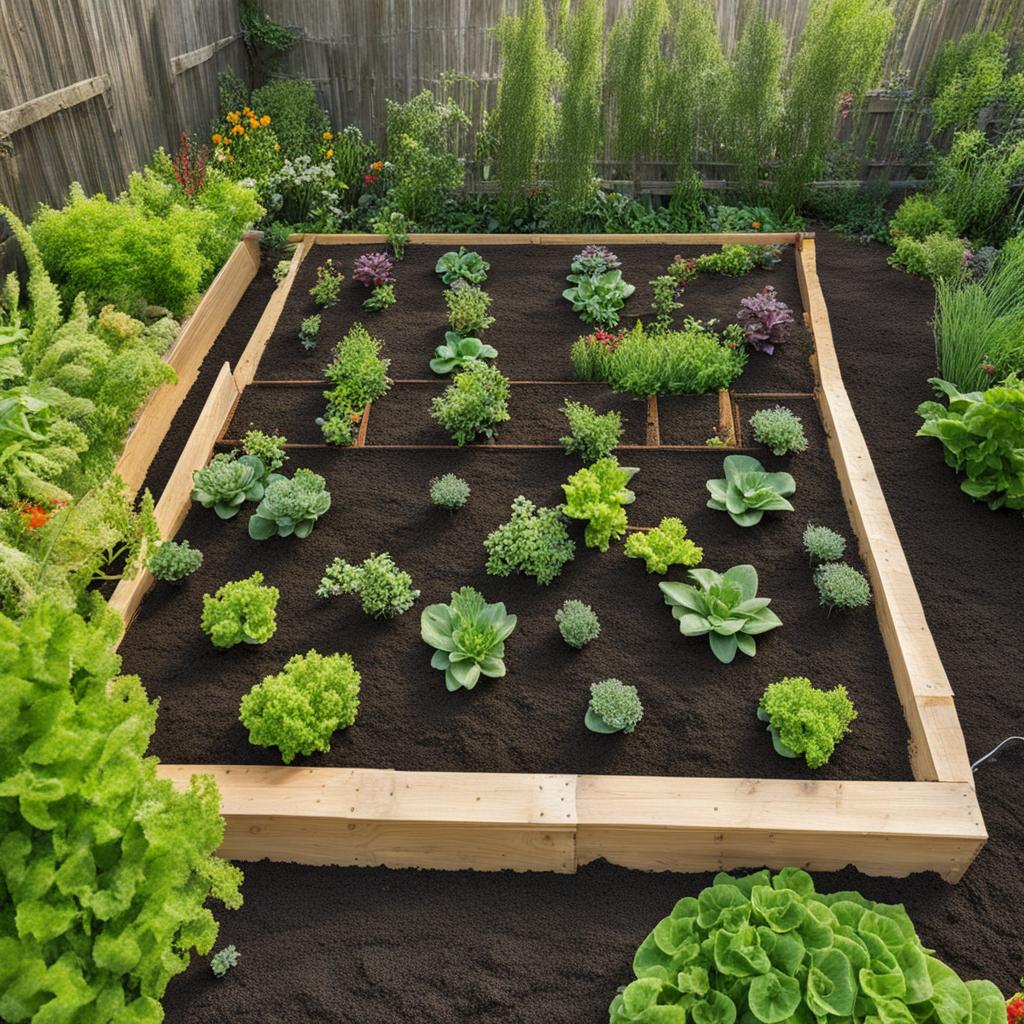
If you’re passionate about vegetable gardening but lack space in your garden, building a raised garden bed is an excellent solution. Not only does it allow you to grow your own fresh and organic vegetables, but it also adds visual interest to your outdoor space.
Creating a raised garden bed is a straightforward DIY project that requires a few basic materials. Start by choosing the location for your raised bed, ensuring it receives adequate sunlight. Then, gather wood boards and cut them to your desired dimensions. Assemble the boards into a rectangular shape and secure them with nails or screws. Make sure the bed is level and secure before filling it with soil.
Opt for organic potting soil to ensure the health and vitality of your vegetables. You can start your garden from seeds or opt for bedding plants depending on your preference and the time of year. Choose vegetables that suit your taste and are well-suited to your climate. Popular choices for raised garden beds include tomatoes, peppers, lettuce, carrots, and herbs. Remember to water your garden regularly and provide proper care to ensure a bountiful harvest of fresh, homegrown veggies.
Reviving Outdoor Furniture: Decorate and Refresh
If you’re looking to give your outdoor furniture a new lease on life, there’s no need to spend a fortune on new pieces. With a little creativity and some simple DIY techniques, you can decorate and refresh your existing outdoor furniture to breathe new life into your outdoor space. Whether it’s a worn-out wooden chair or a rusty metal table, here are some ideas to help you transform your outdoor furniture without breaking the bank.
One of the easiest and most effective ways to refresh outdoor furniture is to give it a fresh coat of paint. Consider choosing bold and vibrant colors that can add a pop of personality to your outdoor space. Clean the furniture thoroughly, sand any rough areas, and apply a primer before painting to ensure a smooth and long-lasting finish. Whether you prefer a sleek and modern look or a shabby-chic vibe, a new coat of paint can make a world of difference.
Another way to revive your outdoor furniture is to repurpose old wood or crates to create shelves or display areas. These can be used to showcase your potted plants, garden art, or even outdoor lighting. Not only will this add a touch of style and functionality to your outdoor space, but it will also give new purpose to old materials that may have otherwise been discarded.
In addition to painting and repurposing, consider adding decorative elements like cushions, throws, or outdoor rugs to your furniture. These accessories can instantly transform the look and feel of your outdoor seating area, making it more inviting and comfortable. Don’t be afraid to mix and match patterns and colors to create a unique and personalized touch.
With just a little time and effort, you can breathe new life into your outdoor furniture and create a fresh and inviting outdoor space. Whether it’s through a fresh coat of paint, repurposing old materials, or adding decorative accessories, there are endless possibilities to refresh your outdoor furniture and make it the highlight of your outdoor oasis.
Creating a Terracotta Fountain: Natural Outdoor Charm
Incorporating a terracotta fountain in your outdoor space can add a touch of natural charm and create a soothing atmosphere. With just a few materials and some DIY skills, you can build a custom fountain that fits perfectly in your garden.
To create a terracotta fountain, you will need:
- Terracotta planters in various sizes
- A water pump
- PVC pipe or tubing
- A circular saw
- A drill
Begin by arranging the terracotta planters in a stacked formation, with the largest planter at the bottom and the smallest at the top. Make sure the drainage holes in each planter align with the one above it. Use a drill to create a hole in the center of each planter’s base large enough to accommodate the PVC pipe or tubing.
Next, insert the PVC pipe or tubing through the holes in the planters, securing them in place with a waterproof adhesive. Connect the water pump to the bottom of the pipe or tubing, ensuring a secure fit. Test the fountain by filling the largest planter with water and turning on the pump. Adjust the water flow as needed.
Once the fountain is functioning properly, you can add decorative elements to enhance its natural charm. Consider adding pebbles, small rocks, or aquatic plants to the planters surrounding the fountain. These additions will create a visually appealing and cohesive look.
A terracotta fountain provides not only a stunning focal point in your garden but also the soothing sound of flowing water. Whether you place it on a patio, in a flower bed, or amidst a lush green backdrop, a terracotta fountain is sure to bring a sense of tranquility to your outdoor space.
Seasonal Decorative Elements: Add Color and Interest
When it comes to enhancing the beauty of your garden, incorporating seasonal decorative elements can make a big impact. These elements not only add color and interest to your outdoor space but also create a vibrant and inviting atmosphere. By choosing unique containers, creating colorful displays, and incorporating seasonal flowers, you can transform your garden into a stunning oasis.
One way to add flair to your garden is by using unique containers. Think beyond traditional plant pots and explore unconventional options like vintage vases, old washtubs, or colanders. These containers not only provide a charming and whimsical touch but also serve as eye-catching focal points in your garden.
“The beauty of a garden is reflected in the uniqueness of its containers.”
Creating colorful displays is another way to elevate the look of your garden. Plant pots with seasonal flowers like hyacinths, daffodils, or tulips in the spring, and cosmos, sweet peas, or snapdragons in the summer. These vibrant blooms will not only brighten up your garden but also attract pollinators and add a touch of seasonal charm.
By incorporating seasonal decorative elements into your garden, you can create a space that is constantly evolving and captivating. Whether it’s through unique containers, colorful displays, or seasonal flowers, these elements will add personality and visual interest to your outdoor oasis.
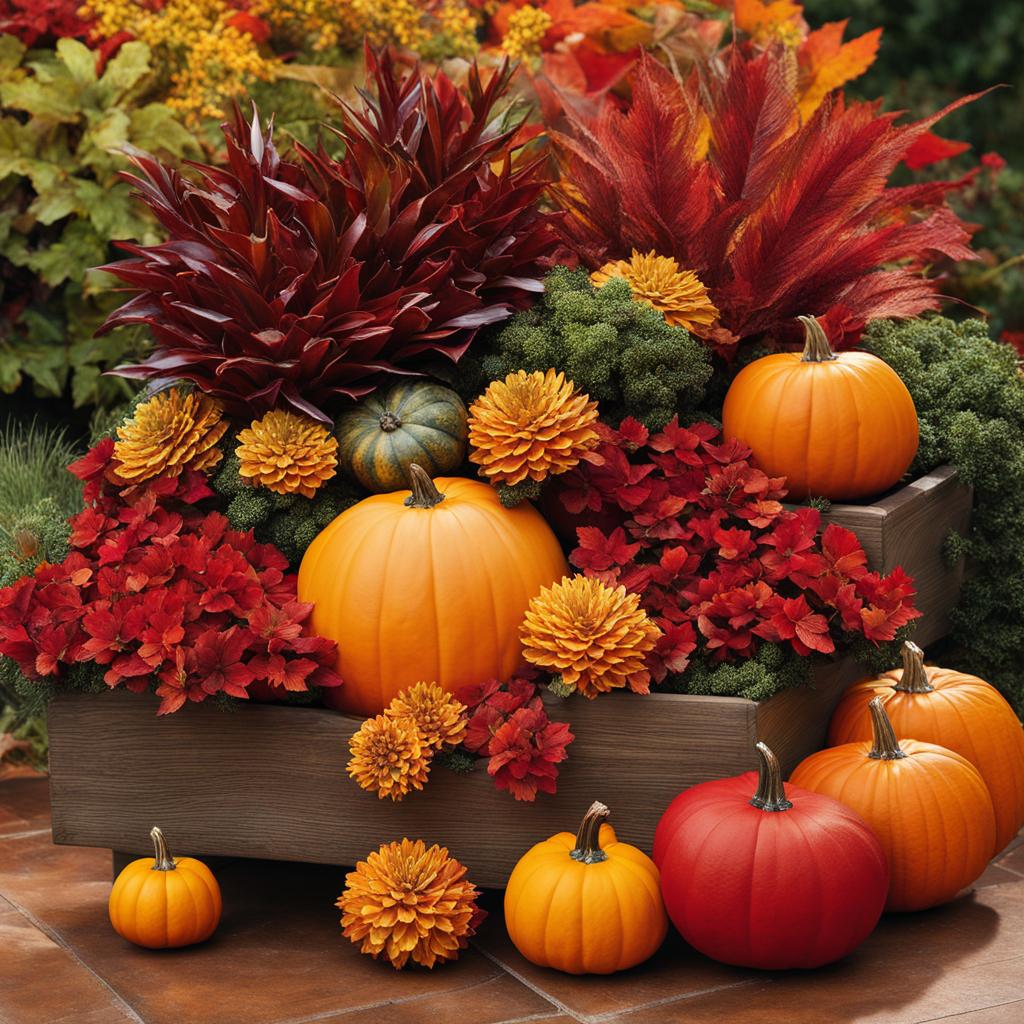
Table: Seasonal Flowers for Colorful Displays
| Season | Flowers |
|---|---|
| Spring |
|
| Summer |
|
DIY Mini Planters: Upcycle and Beautify
If you’re looking for a creative way to repurpose old glass jars and containers, why not turn them into charming mini planters? This simple DIY project allows you to upcycle common household items while beautifying your space with greenery. Not only is it a sustainable option, but it also adds a personal touch to your garden or indoor decor.
To get started, gather your glass jars and containers. You can use mason jars, old candle holders, or even small glass bottles. Clean them thoroughly to remove any residue or labels. Once clean and dry, you can begin the transformation.
One idea is to spray paint the jars with leftover acrylic paint or use old paint tester pots to give them a fresh look. Get creative with colors and patterns that suit your style. You can also add a special touch by painting names or initials on the jars. This personalization makes the mini planters unique and adds a personalized touch to your space.
Once your jars are painted and dry, it’s time to fill them with plants. Choose small herbs or other small plants that are suitable for the size of the jars. Consider plants like basil, mint, or succulents that thrive in containers. Fill the jars with potting soil and carefully plant the herbs or plants. Be sure to provide adequate drainage by adding small stones or pebbles to the bottom of the jars before filling them with soil. Finally, place your new DIY mini planters on a windowsill, shelf, or outdoor table to enjoy their beauty and the freshness they bring to your space.
Benefits of DIY Mini Planters
There are several benefits to creating your own mini planters:
- Cost-effective: Upcycling old glass jars and containers saves money and reduces waste.
- Creativity: DIY mini planters allow you to express your creativity and personalize your space.
- Sustainability: Repurposing items is an eco-friendly choice that promotes sustainability.
- Flexibility: With a variety of plants to choose from, you can create mini planters that suit your taste and style.
- Indoor and outdoor use: These mini planters can be displayed indoors on windowsills, shelves, or desks, or outdoors on patios, balconies, or garden beds.
Remember to regularly water and care for your mini planters to ensure the health and longevity of the plants. Enjoy the beauty and freshness these DIY creations bring to your space!
Clay Garden Markers: Label Your Plants
When it comes to organizing and labeling your plants, clay garden markers are a charming and practical solution. These DIY markers not only add a rustic touch to your garden but also help you keep track of your plant varieties. Making your own clay garden markers is a fun and creative project that allows you to personalize each marker with the name of the plant it represents.
To create your clay garden markers, start by shaping a piece of modeling clay into a small rectangle or any shape you prefer. Then, use alphabet stamps to press the name of the plant onto the clay. Alternatively, you can carve the name into the clay using a knife. Once you’re satisfied with the markings, bake the clay according to the manufacturer’s instructions to solidify the labels.
After your clay garden markers have cooled, you can place them next to your plants in the garden or in pots. These markers not only serve a practical purpose but also add a decorative element to your outdoor space. They make it easy to identify different plant varieties and create an organized and visually appealing garden.
| Benefits of Clay Garden Markers |
|---|
| 1. Personalization: Each clay garden marker can be customized with the name of the plant, adding a personal touch to your garden. |
| 2. Durability: Once baked, clay garden markers become sturdy and weather-resistant, ensuring they can withstand outdoor conditions. |
| 3. Aesthetic Appeal: The rustic look of clay garden markers adds charm and character to your garden, enhancing its overall aesthetic. |
| 4. Organization: By labeling your plants with clay markers, you can easily keep track of different varieties and maintain an organized garden. |
With clay garden markers, you can bring a touch of creativity and organization to your garden. Whether you’re a seasoned gardener or just starting out, these markers can help you keep track of your plants and showcase your personal style. So, gather your materials and start making your own clay garden markers today!
Conclusion
So, there you have it – the best ideas for planter to inspire growth and transform your outdoor space. By embracing the latest gardening trends, such as hortifuturism and gothic gardens, you can create a garden that is vibrant and captivating.
Consider incorporating vibrant and futuristic planters in bold colors, like neon green or hot pink, to add a pop of color to your garden. Combine these with neon-colored plants and foliage to create a visually stunning display.
Don’t forget to prioritize sustainability by choosing native and carbon-capturing plants. This will not only benefit the environment but also create a garden that is well-suited to your local climate and requires less maintenance.
By implementing these ideas, you can achieve a truly transformative outdoor space that is both visually appealing and environmentally friendly. So, get ready to unleash your creativity, nurture your plants, and enjoy the benefits of a beautifully designed garden.
FAQ
What are some popular planter design ideas?
Some popular planter design ideas include using vibrant and futuristic planters, incorporating gothic garden elements, attracting pollinators with specific plants, maximizing vertical space with container gardening, and creating sustainable and native gardens.
How can I embrace hortifuturism in my garden?
To embrace hortifuturism, choose planters in vibrant shades like neon green, electric blue, or hot pink. Fill these planters with neon-colored plants and foliage with bright variegation to create a truly eye-catching display.
What are some gothic garden ideas?
Gothic garden ideas include incorporating eerie plants like black roses, dark purple lilies, or deep red tulips. Use gothic-inspired pottery and statuary to add a haunting touch, and focus on evening experiences by uplighting trees and allowing plants to grow a bit untidy.
What are some plant choices to attract bees and butterflies?
To attract bees and butterflies, grow pollinator plants like bee balm, asters, and goldenrod. These plants provide food and habitat for these insects and add color and beauty to your garden.
How can I maximize vertical space in my garden?
To maximize vertical space, use hanging planters and trailing plants. Hang planters from walls, fences, or pergolas and choose trailing plants like ivy, petunias, or trailing succulents to add depth and interest to your container garden.
How can I create an eco-friendly garden?
Create an eco-friendly garden by filling it with native plants that are well-suited to your local climate. Choose plants that capture carbon and use compost and organic fertilizers to nourish your plants and reduce waste.
How can I incorporate fluoro green in my garden?
Incorporate fluoro green by choosing lime-colored plants like lime-colored hydrangeas or lime foliage plants. This color can be paired with bright orange, yellow, fuchsia pink, or even black, and complements both hot and cool colors.
What are some top picks for lime-colored plants?
Some top picks for lime-colored plants include lime-colored coneflowers, Mediterranean spurge, Nicotiana alata ‘Lime Green’, allium convallarioides, chrysanthemum ‘Anastasia Green’, gladiolus ‘Green Star’, and coral bells ‘Lime Marmalade’.
How can I transform my outdoor space on a budget?
To transform your outdoor space on a budget, consider rearranging furniture, repainting outdoor items, adding pops of color through planters with seasonal flowers, repurposing old items for shelves or decorative elements, and adding outdoor lights or lanterns for enhanced ambiance.
How can I build a raised garden bed?
To build a raised garden bed, gather simple materials like wood boards, nails, and screws. Use organic potting soil and choose vegetable seeds or bedding plants that suit your taste. A raised garden bed provides a convenient way to grow fresh veggies and adds visual interest to your outdoor space.
How can I revive my outdoor furniture?
To revive outdoor furniture, consider repainting it with a new coat of paint in bold colors. Repurpose old wood or crates to create shelves or other decorative elements. These simple DIY projects can add style and functionality to your outdoor area.
How can I create a terracotta fountain?
To create a terracotta fountain, use terracotta planters, a water pump, pipes, and basic tools like a circular saw and drill. Build a custom fountain that fits your garden perfectly, providing a tranquil and soothing atmosphere.
How can I add seasonal decorative elements to my garden?
Add seasonal decorative elements to your garden by planting pots with flowers that bloom in different seasons. Get creative with containers, opting for unique items like vintage vases, old washtubs, or colanders. These containers add charm and personality to your garden.
How can I create DIY mini planters?
Create DIY mini planters by repurposing old glass jars and containers. Spray paint them with leftover acrylic paint or use old paint tester pots to give them a new look. These mini planters can be used to display herbs or other small plants, and they make great gifts.
How can I label my plants in the garden?
Label your plants in the garden with clay garden markers. Use clay, alphabet stamps, and basic tools like a knife and baking sheet to create personalized markers. Place these markers next to your plants to easily identify and label them.

